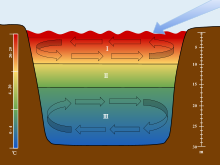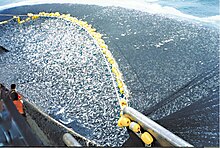User:Vecchiam/sandbox
Aquatic Ecosystems[edit]
Types[edit]
Lentic[edit]

Stratification and Mixing[edit]
Lakes can also be divided by thermal stratification. Thermal stratification can be defined as the separation of the water column by temperature and mixing differences. Typically, in temperate lakes, there is a yearly pattern of this stratification scheme[1]. These lakes tend to be dimictic, meaning that they stratify in the summer and winter and have mixing periods in the spring and fall. This is due to solar radiation raising the temperature of the surface of the lake, the epilimnion (See figure - Layer I).This temperature difference and associated density differences, prevent mixing with deeper layers of the lake. Water within the epilimnion mixes, and this tends to be the warmest layer within the lake. Below the epilimnion is the metalimnion, also called the thermocline (See figure - Layer II). This layer is the portion of the lake where temperature declines with depth and little mixing occurs. The lower layer of the lake is called the hypolimnion. Mixing occurs within the hypolimnion, creating a relatively consistent temperature in this layer; however, this layer does not mix with the other layers (See figure - Layer III). [1]
Other stratification schemes can be seen in lakes including monomictic, polymictic and meromictic [1]. In monomictic lakes, the mixing and stratification each occurs only once a year. Polymictic lakes are lakes that stratify and then mix many times in a year, typically due to being too shallow to maintain stratification for extended periods. Meromictic lakes have a layer that does not ever mix called the monimolimnion. [1] This layer lies at the bottom of the lake and does not mix because its water is more dense than layers above it, usually due to high concentrations of salts.
Functions[edit]
Environmental Impacts[edit]
Human populations can impose excessive stresses on aquatic ecosystems.[2] There are many examples of excessive stresses with negative consequences. The environmental history of the Great Lakes of North America illustrates this problem, particularly how multiple stresses, such as water pollution, over-harvesting and invasive species can combine.[3] The Norfolk Broadlands in England illustrate similar decline with pollution and invasive species.[4] Lake Pontchartrain along the Gulf of Mexico illustrates the negative effects of different stresses including levee construction, logging of swamps, invasive species and salt water intrusion.[5]
Pollution[edit]
Pollution of water can take 2 forms, macropollutants and micropollutants. Macropollutants include substances such as nitrogen and phosphorus. These run off from agriculture and can pollute the waterways by causing harmful algal blooms, leading to deoxygenation and dead zones. Other macropollutants include salt from salting roadways in the winter. This can cause water to become salinized and unable to be used as drinking water. Micropollutants are also released into waterways but typically at much lower concentrations. Despite this, these pollutants can be much more toxic. Unfortunately, most water treatment does not properly remove these pollutants. [6]
There are also more tangible forms of pollution such as plastics. It is inevitable that plastics end up in the ocean, especially with the ever increasing use of the oceans for industrial uses and coastlines for recreation and immigration to these costal areas. There have been efforts to clean up the ocean by skimming the water to remove floating plastics, however these techniques miss all of the plastics in the middle water and in the sediments, and therefore estimates of how much plastic is actually in the oceans is likely starkly underestimated. While most research has focused on larger plastics such as those that entangle or are ingested by marine life like turtles, fish and sea birds, another form of plastics are gaining attention, microplastics. A major concern over microplastics includes their tendency to attract persistent organic pollutants (POPs). These POPs are typically at very low concentrations in the ocean, however they can become extremely concentrated on microplastics. When microplastics are ingested by organisms, the POPs come along with them and thereby enter the food web. The effects of this are not yet well known.[7]

Overharvesting[edit]
Overharvesting/overfishing is when people remove fish or other organisms faster than the can be replenished.[8] This is a problem in both marine and freshwater ecosystems and is having a major impact on food web interactions and therefore leading to changes in local biodiversity and populations. [9] Even small changes to the food chain such as the removal of some predators can lead to a trophic cascade, affecting the whole food web. Changes can happen at the species level too, affecting the size and development rate of the remaining fish. Humans are also a major part of this food web. When overfishing occurs, there is a reduction in food security especially in costal communities. This also contributes to the economic stability of these regions, leading to a loss of jobs and businesses.[8]
Invasive Species[edit]
Invasive species are those that have expanded from their original range and had a significant impact on their new environment. This is often caused by humans transporting these species either intentionally or unintentionally. Similar to overharvesting, large changes in structure of a food web can occur with the introduction of another species. For example, in Lake Erie, the introduction of the zebra mussel resulted in a large decrease in phytoplankton resulting in a large decrease in zooplankton and an increase in light penetration, leading to an increase in vascular plants, drastically changing the structure of the lake. [10]
Climate Change[edit]

As with pollution from salting roadways, sea level rise has lead to an increase in saltwater intrusion, where saltwater enters freshwater including groundwater, rivers, lakes and streams. This has become a particularly prominent issue in Asia where there has been great overuse of groundwater and aquifers.[6] In addition to this, the increase in temperature as a result of climate change is having some effects on the aquatic ecosystems themselves. Coral bleaching, as a result of increased temperatures in the ocean, has become a major concern of climate change. These events can drastically change the coral reef by reducing the coral cover and removing essential habitat for the biota that live within and around the coral. [11] Freshwater systems are also seeing the effects of climate change. Lakes will increasingly see changes in their stratification regimes. As warming occurs, there will be lengthened summer stratification and reduced winter stratification. As ice cover is reduced and eventually disappears, we will eventually see a shift of dimictic lakes to monomictic lakes, with only one occurrence of mixing and stratification per year, drastically affecting the biota that live within these lakes. [12]
Biotic Characteristics[edit]
Heterotrophic Organisms[edit]
These organisms cannot make their own food but rather rely on other organisms for their energy and nutrients, making them higher order producers. All animals, including humans, are heterotopic as are fungi and some bacteria and protists.[13]
 | This is a user sandbox of Vecchiam. You can use it for testing or practicing edits. This is not the sandbox where you should draft your assigned article for a dashboard.wikiedu.org course. To find the right sandbox for your assignment, visit your Dashboard course page and follow the Sandbox Draft link for your assigned article in the My Articles section. |
- ^ a b c d "Water on the Web | Understanding | Lake Ecology | Density Stratification". www.waterontheweb.org. Retrieved 2020-10-18.
- ^ Loeb, Stanford L. (24 January 1994). Biological Monitoring of Aquatic Systems. CRC Press. ISBN 0-87371-910-7.
- ^ Vallentyne, J. R. (1974). The Algal Bowl: Lakes and Man, Miscellaneous Special Publication No. 22. Ottawa, ON: Department of the Environment, Fisheries and Marine Service.
- ^ Moss, B. (1983). The Norfolk Broadland: experiments in the restoration of a complex wetland. Biological Reviews of the Cambridge Philosophical Society, 58, 521–561.
- ^ Keddy, P. A., Campbell, D., McFalls T., Shaffer, G., Moreau, R., Dranguet, C., and Heleniak, R. (2007). The wetlands of lakes Pontchartrain and Maurepas: past, present and future. Environmental Reviews, 15, 1–35.
- ^ a b Rene Schwarzenbach, Thomas Egli, Thomas B. Hofstetter, Urs von Gunten, Bernhard Wehrli (August 16, 2010). "Global Water Pollution and Human Health". The Annual Review of Environment and Resources. 35: 109–136.
{{cite journal}}: CS1 maint: multiple names: authors list (link) - ^ Andrady, Anthony (August 2011). "Microplastics in the marine environment". Marine Pollution Bulletin. 62: 1596–1605 – via ScienceDirect.
- ^ a b "Overfishing". World Wildlife Fund. Retrieved 2020-10-18.
- ^ Valentine, John F.; Heck, Kenneth L. (2005). "Perspective review of the impacts of overfishing on coral reef food web linkages". Coral Reefs. 24 (2): 209–213. doi:10.1007/s00338-004-0468-9. ISSN 0722-4028.
- ^ Havel, John E.; Kovalenko, Katya E.; Thomaz, Sidinei Magela; Amalfitano, Stefano; Kats, Lee B. (2015). "Aquatic invasive species: challenges for the future". Hydrobiologia. 750 (1): 147–170. doi:10.1007/s10750-014-2166-0. ISSN 0018-8158. PMC 7087615. PMID 32214452.
{{cite journal}}: CS1 maint: PMC format (link) - ^ Baker, Andrew C.; Glynn, Peter W.; Riegl, Bernhard (10 December 2008). "Climate change and coral reef bleaching: An ecological assessment of long-term impacts, recovery trends and future outlook". Estuarine, Coastal and Shelf Science. 80 (4): 435–471. doi:10.1016/j.ecss.2008.09.003. ISSN 0272-7714.
- ^ Woolway, R (August 2020). "Global lake responses to climate change". Nature Reviews. 1: 388–403.
- ^ Bradley, Kiran (2019). Reproduction in Bacteria. United Kingdom: EDTECH. pp. 225–226. ISBN 9781839473562.
